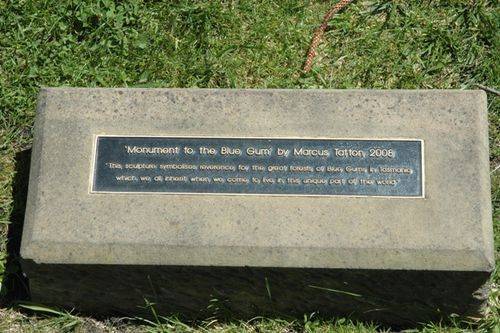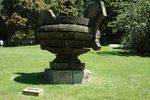
Monument to the Blue GumPrint Page 
The sculpture commemorates the Blue Gum forests of Tasmania. The Tasmanian Blue Gum, Eucalypts globulus, was proclaimed as the floral emblem of Tasmania on 27 November 1962.
Eucalyptus globulus was first collected on the south-east coast of Tasmania in 1792-93 by Jacques-Julien Houten de Labillardiere (1755 - 1834) and described by him in 1799. He was a distinguished French botanist who accompanied Bruny D'Entrecasteaux on the expedition in La Recherche and L'Esperance in 1791-94 in search of their missing compatriot, La Perouse. The two ships of the expedition led by La Perouse landed at Botany Bay on 26 January 1788. They departed six weeks later and forty years elapsed before their fate was established by the discovery of wreckage at Santa Cruz, north of the New Hebrides. Labillardiere was a keen collector of plants and animals and also recorded detailed accounts of the appearance and customs of the Australian Aboriginals he observed. His plant specimens are now housed in the Museum of Florence.
Eucalyptus globulus now includes several subspecies of which E. globulus subsp. globulus is the Tasmanian emblem. The generic name Eucalyptus is derived from the Greek 'eu', meaning 'well', and 'kalypto', meaning 'to cover, as with a lid', referring to the operculum, a cap-like structure which protects the stamens in the bud and is shed when the flower opens. The operculum is a distinguishing feature of all species of Eucalyptus. The specific name globulus, from the Latin meaning 'ball-like' or 'spherical', refers to the shape of the fruit. The genus Eucalyptus numbers about 800 species which are widely distributed in Australia, with a few species occurring in some of the islands to the north. It belongs to the family Myrtaceae, which is widespread in Australia and tropical regions of the Americas.
Tasmanian Blue Gum is a tall, straight tree growing to 70 metres in height and 2 metres in trunk diameter under favourable conditions. The rough, deeply furrowed, grey bark is persistent at the base of the trunk but above this level it is shed in strips leaving the branches and the greater length of the trunk smooth-barked. The broad juvenile leaves, borne in opposite pairs on square stems, are about 6 to 15 cm long and covered with a blue-grey, waxy bloom. This is the origin of the common name 'blue gum'. The mature leaves are narrow, sickle-shaped and dark shining green. They are arranged alternately on rounded stems and range from 15 to 35 cm in length. The buds are top-shaped, ribbed and warty and have a flattened operculum bearing a central knob. The cream flowers are borne singly in the leaf axils and produce copious nectar which tends to yield a strongly flavoured honey. The woody fruits range from 1.5 to 2.5 cm in diameter. Numerous small seeds are shed through valves which open on the top of the fruit.
Eucalyptus globulus subsp. globulus occurs in tall open forest in south-eastern Tasmania and to a lesser extent along the eastern coast of the State. It also occurs on King and Flinders Islands in Bass Strait. Outside Tasmania it is confined to Wilson's Promontory and the Cape Otway district in southern Victoria. The climate throughout its range is cool to mild, with wet winters and reliable summer rainfall. Within parts of its range, light frosts and snowfalls occur.
Tasmanian Blue Gum is protected in conservation areas such as Maria Island National Park, Freycinet National Park, Tasman Arch Nature Reserve and St Mary's Pass Nature Reserve. Outside State reserves it occurs in reserves managed by the Department of Lands and the Forestry Commission. Both authorities have regulations prohibiting the taking of native flora from Crown Land and State forests respectively without prior permission of the managing authority.
Location
| Address: | Lower Domain Road, Queens Domain, Royal Tasmanian Botanical Gardens, Hobart, 7000 |
|---|---|
| State: | TAS |
| Area: | AUS |
| GPS Coordinates: | Lat: -42.867884 Long: 147.331224 Note: GPS Coordinates are approximate. |
Details
| Monument Type: | Sculpture |
|---|---|
| Monument Theme: | Culture |
| Sub-Theme: | Community |
| Artist: | Marcus Tatton |
Dedication
| Approx. Monument Dedication Date: | 2008 |
|---|
`Monument to the Blue Gum` by Marcus Tatton, 2008
"This sculpture symbolises reverence for the great forests of Blue Gum in Tasmania which we all inherit when we come to live in this unique part of the world"






